Art & Exhibitions
Marisol Reclaims Her Spot in the Pop Art Canon at a Vast New Show
A major gift from the artist is helping put her back in the spotlight.
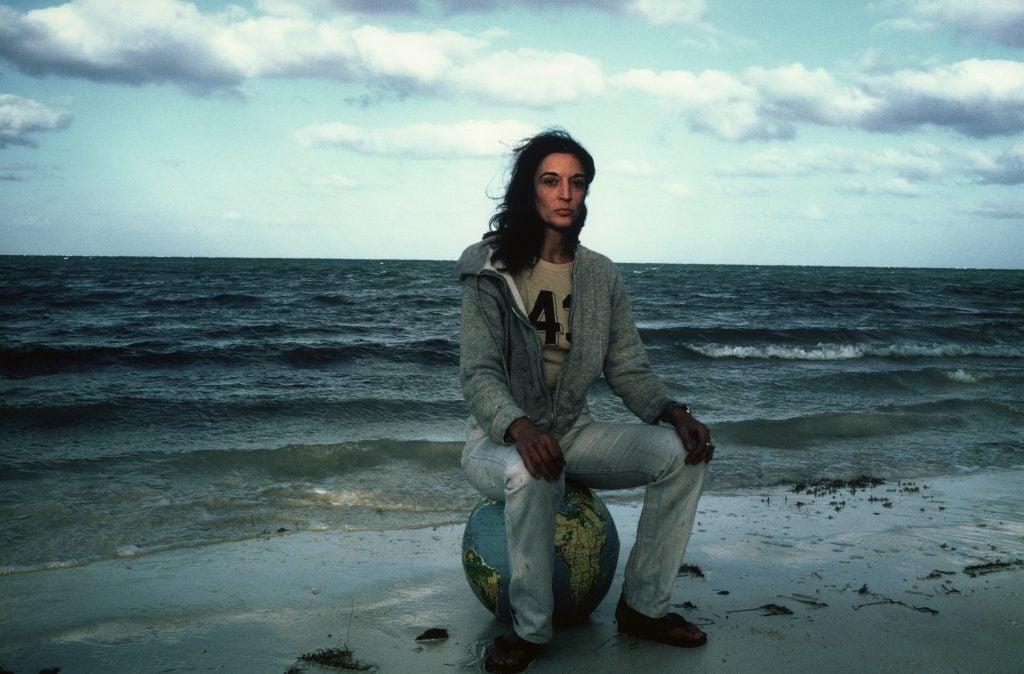
An exhibition six years in the making has come home at long last to Western New York, with the arrival of “Marisol: A Retrospective” at the Buffalo AKG Art Museum.
It’s the largest show of its kind for the mononymic Venezuelan American artist, who grew up between her birthplace of Paris, New York, and Los Angeles. Born María Sol Escobar, Marisol (1930–2016) was a darling of the Pop art movement.
Embraced by the art establishment—in 1968 alone she was in both the Venice Biennale and Documenta in Kassel, West Germany—Marisol also achieved mainstream fame, with more press than Andy Warhol in the 1960s. But she retreated from the New York art world and fell into obscurity.
Like too many women artists, she was basically written out of art history. “Marisol: A Retrospective” looks to right that wrong.
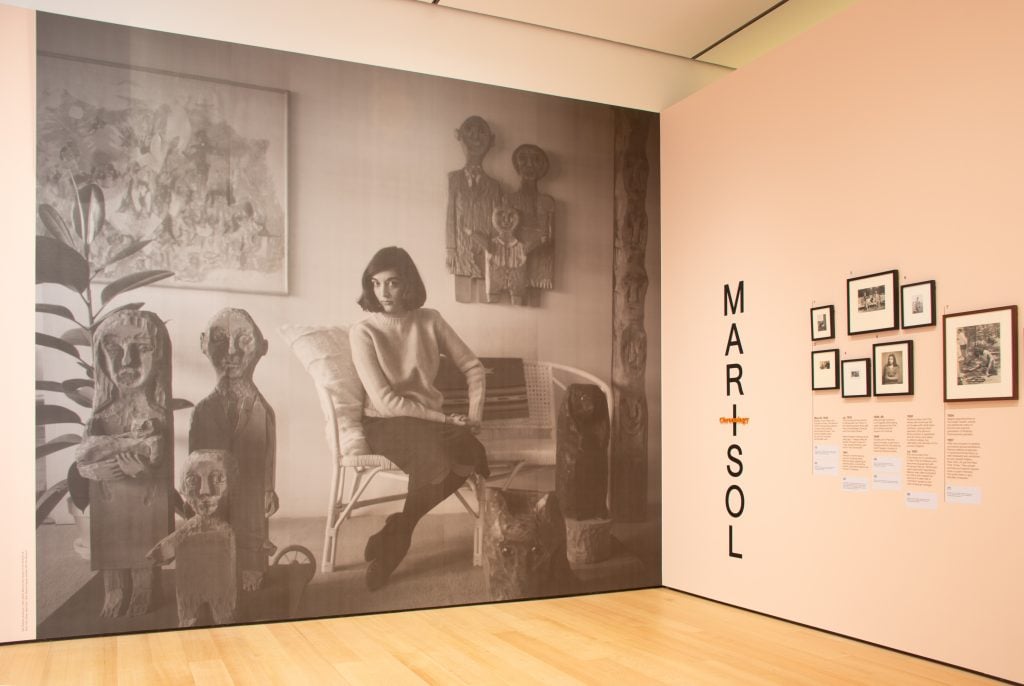
“Marisol: A Retrospective,” installation view at the Buffalo AKG Art Museum. Photo by Brenda Bieger, courtesy of the Buffalo AKG Art Museum.
Due to a massive three-year expansion project at the AKG, formerly the Albright-Knox Art Gallery, that was completed just over a year ago, the show had to open on the road. It debuted at the Montreal Museum of Fine Arts last fall before traveling to the Toledo Museum of Art, and will end its tour next year at the Dallas Museum of Art.
But the exhibition wouldn’t have ever happened were it not for Marisol’s somewhat mysterious decision to leave her entire estate to the Buffalo AKG upon her death. The museum was the first institution to acquire her work, and her longtime dealer, Sidney Janis, hailed from Buffalo, but Marisol never really offered a full explanation as to her reasoning.
Whatever the thinking behind the bequest, it was an undeniably transformational gift for the AKG. The museum had an inkling Marisol was including it in her will, but no one was ready for the extent of the gift until a fax from the lawyers arrived. The AKG would get it all—even her Tribeca loft.
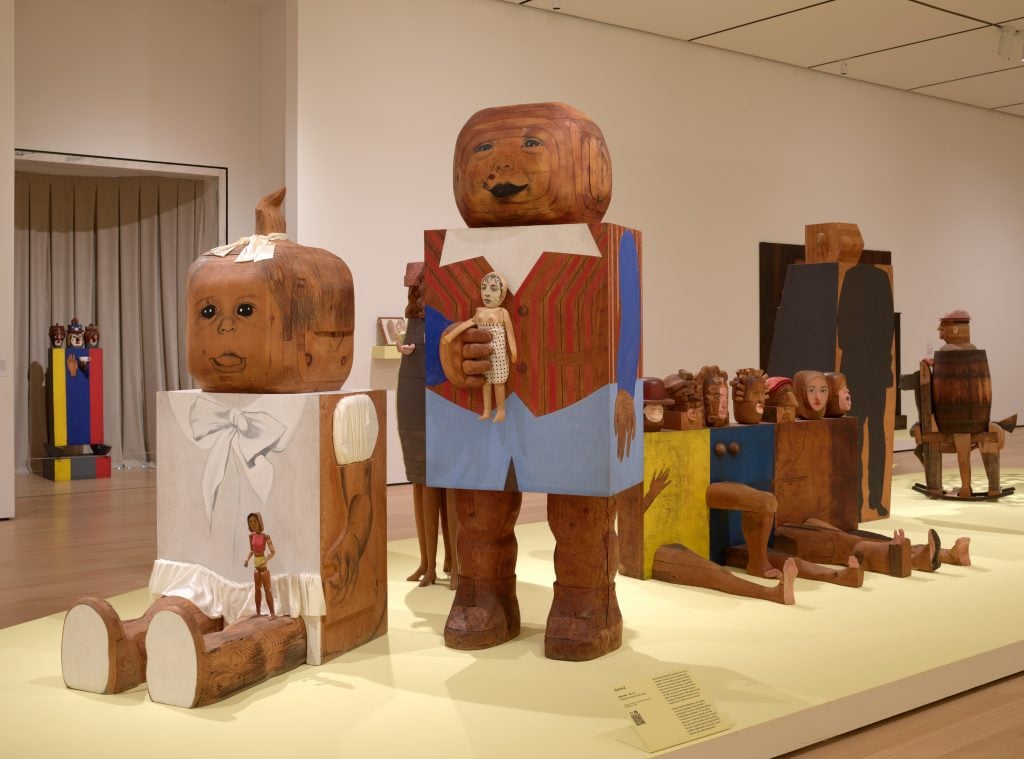
“Marisol: A Retrospective,” installation view at the Buffalo AKG Art Museum. Photo by Brenda Bieger, courtesy of the Buffalo AKG Art Museum.
“We went to the apartment and they gave us the keys,” Cathleen Chaffee, the museum’s chief curator, recalled during the exhibition press preview.
The museum later sold the property, which included Marisol sketches on the walls, for $5.79 million. (The proceeds went toward the endowment.)
“When we walked into the apartment for the first time, it was so evident that this was the person who lived entirely for and with her art,” Chaffee said. “Marisol had this little bedroom and little kitchen and living room—and a whole loft filled with art. It was storage, crates, with sculptures all installed.”
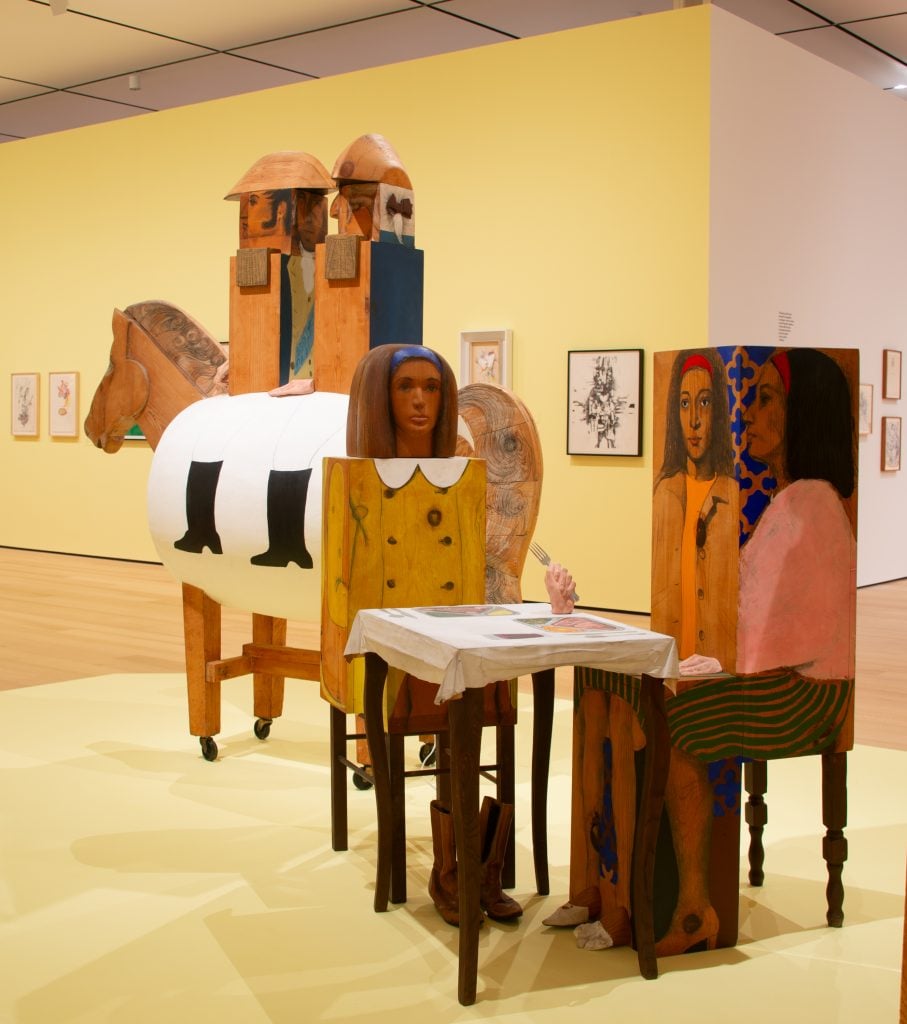
“Marisol: A Retrospective,” installation view at the Buffalo AKG Art Museum with The Generals and Dinner Date. Photo by Brenda Bieger, courtesy of the Buffalo AKG Art Museum.
Sorting through the rest of the estate has been a years-long process, with the museum slowly but surely accessioning hundreds of works, many of which haven’t been seen for decades. The institution now has the world’s most significant Marisol collection. (Chaffee is still evaluating, but expects that for series from which it now owns multiple works, there may be opportunities to sell some pieces to other museums.)
Suddenly responsible for the legacy of one of Pop art’s most enigmatic figures, the AKG set out to put together an exhibition that would do Marisol justice. It was a massive undertaking.
The bequest meant that there was a wealth of both artworks and archival materials to draw from—but also that when it came to putting together the catalogue, the museum had to photograph and document it all from scratch.
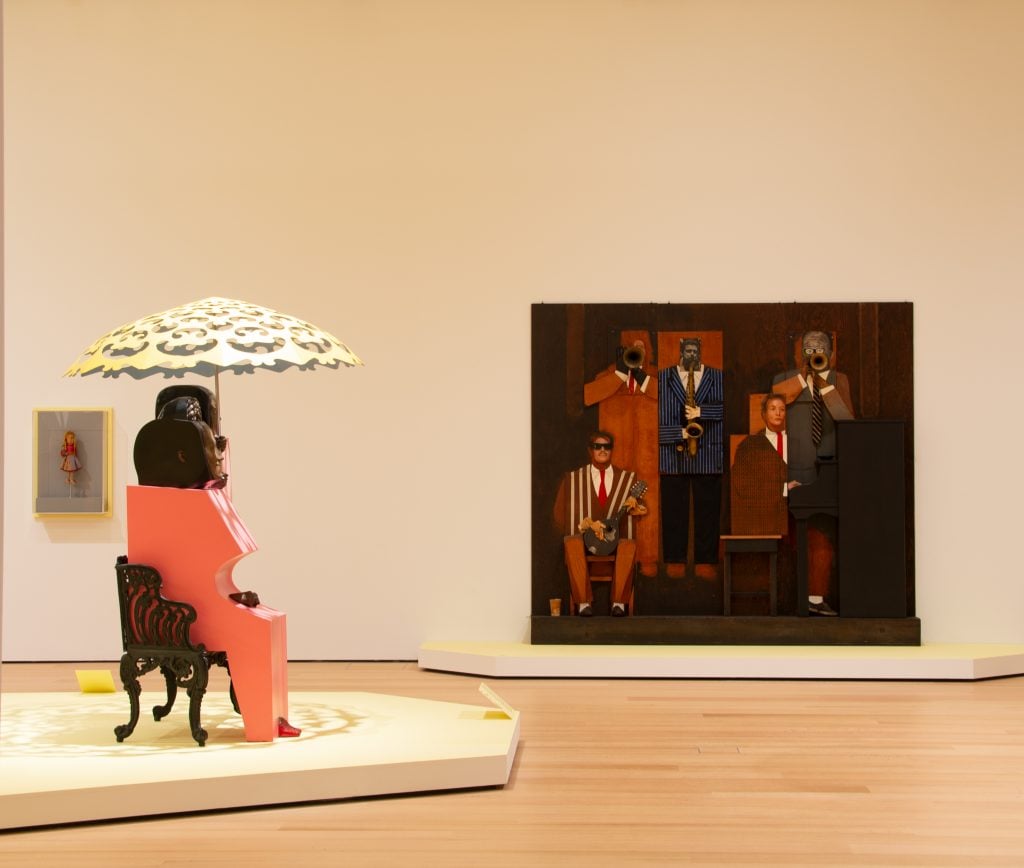
“Marisol: A Retrospective,” installation view at the Buffalo AKG Art Museum with Mi Mama Y Yo (1968) and The Jazz Wall (1963). Photo by Brenda Bieger, courtesy of the Buffalo AKG Art Museum.
“So many of the works in the bequest were unpublished, and many of them had never been shown,” Chaffee said.
Marisol studied painting at the Art Students League of New York with Yasuo Kuniyoshi, and at Hans Hofmann’s art schools in New York and Provincetown. But a chance encounter with a pre-Columbian gallery show inspired her to trade in brush for chisel—despite a lack of training in sculpture.
At the height of Marisol’s fame, she appeared in Life magazine and on the cover of Glamour, with sculptures on the cover of three issues of Time, She was in two films by Warhol, a friend who dubbed her “the first girl artist with glamour.” Press clippings often exoticized the artist—archival materials in the show include an article with the headline “Latin Beauty.”
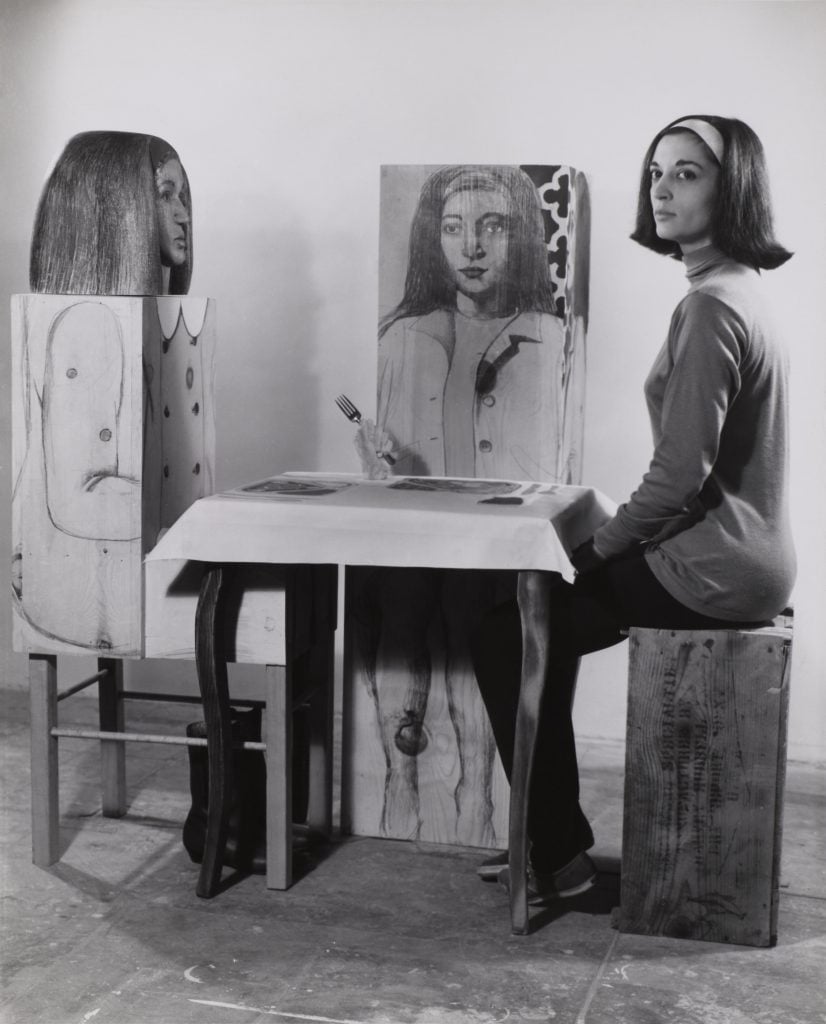
John D. Schiff photograph of Marisol with Dinner Date (1963). Artwork from the collection of the Yale University Art Gallery. Photo from the collection of the Albright-Knox Art Gallery/Buffalo AKG Art Museum; bequest of Marisol, 2016. Marisol Archives, Series 10: Photographs, Subseries 1: Artwork Box Number 7 ©Estate of Marisol/Buffalo AKG Art Museum/Artists Rights Society (ARS), New York.
But it wasn’t just Marisol’s striking looks that caught the art world’s attention. For viewers who (like me) haven’t seen more than a work or two by the Pop artist at a time, the show is nothing short of jaw-dropping.
The galleries are filled with life-size—sometimes larger-than-life—totemic wooden sculptures. It’s a material you don’t see in art museums every day, and Marisol used it to unusual effect.
Some surfaces are finely carved and/or painted, while others remain unfinished and blocky. The mixed media sculptures are made in part from found objects, and can incorporate cast body parts.
“Those things taken together make up sort of the elements that are canonically or quintessentially Marisol,” Chaffee said. “Any one of those really would’ve been enough to not look like anything else [being made by artists] during the sixties. But the way that she combined them, I think, is what creates a lot of visual delight for people.”
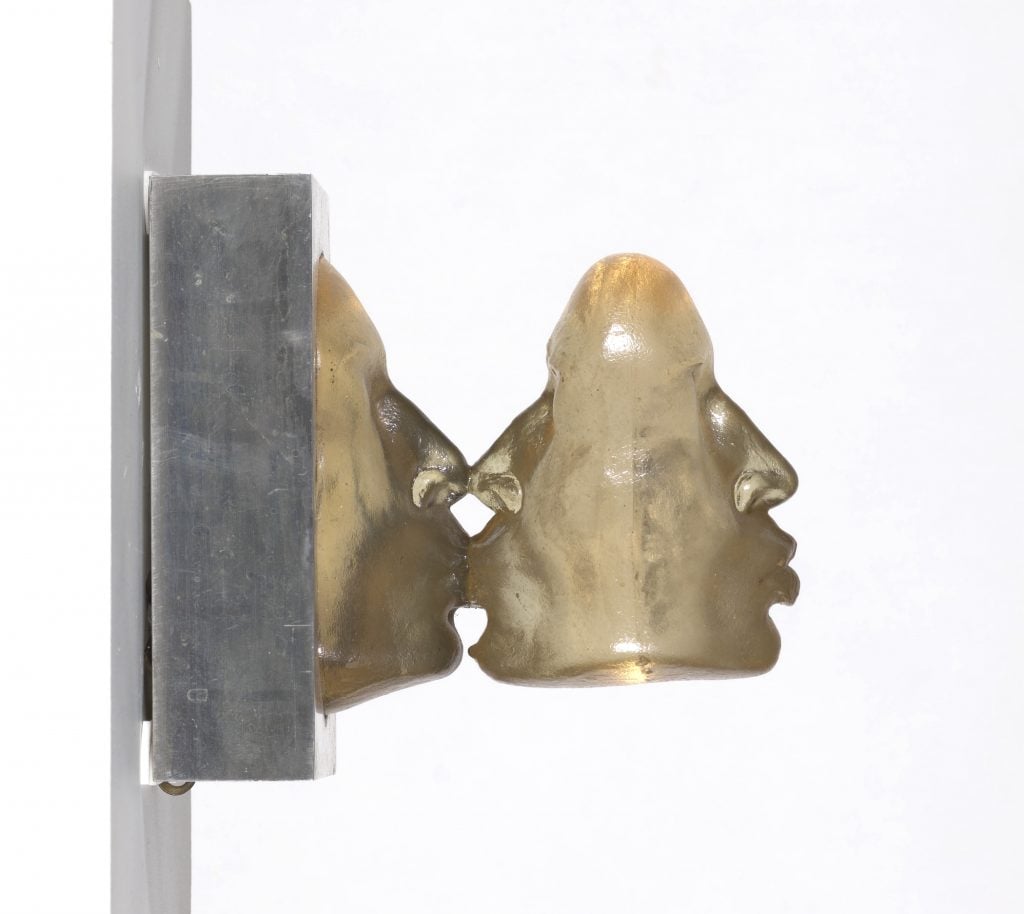
Marisol, Kiss (1966). Collection Buffalo AKG Art Museum. Bequest of Marisol, 2016. ©Estate of Marisol/Artists Rights Society (ARS), New York.
Marisol’s work referenced Folk art, but she did not appreciate being pigeonholed as such. Pablo Picasso, she argued, would never be discussed solely through the lens of his African influences.
The exhibition includes her scathing response to a 1973 Village Voice review by John Perreault that spoke of her “neo-sophisticated appropriation of folk-art forms.” In a response that Marisol may or may not have mailed, she wrote that “if you call my work folk art it is only because you are prejudiced about my South American background. Folk you.”
Selections from Marisol’s archives make clear how varied her influences truly were. Many of her works were based on photographs that she kept in her files for decades, including advertisements, magazine spreads, and news wire images.
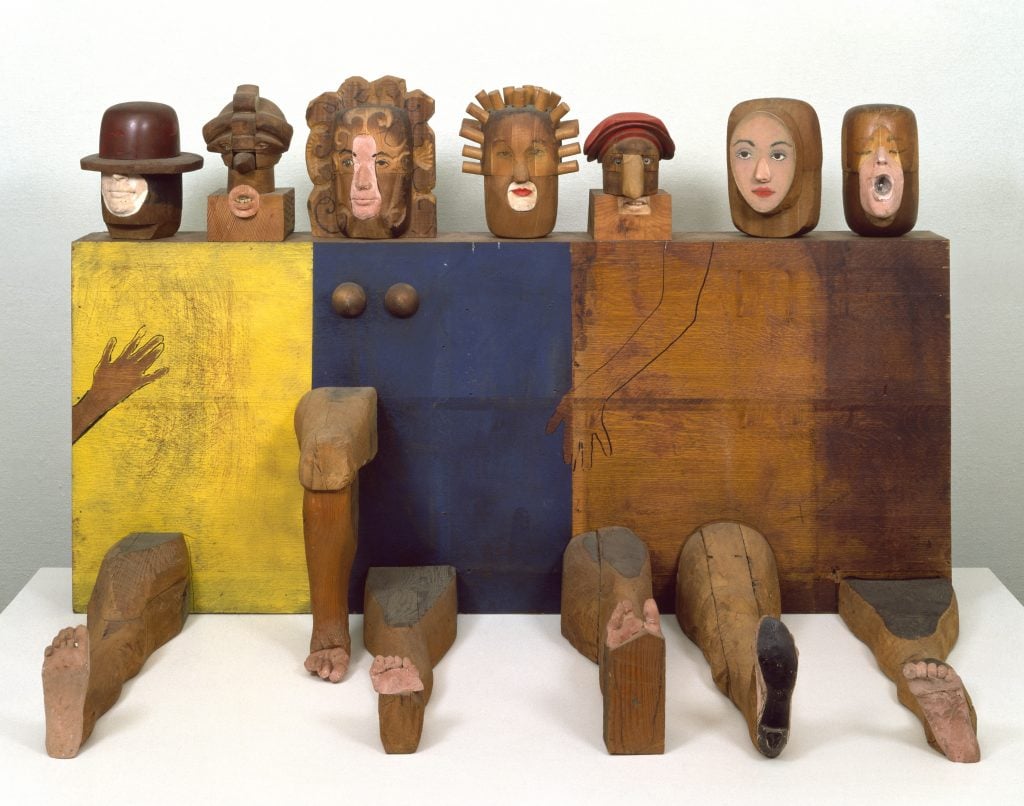
Marisol, Self-Portrait (1961–62). Collection of the Museum of Contemporary Art Chicago, gift of Joseph and Jory Shapiro, ©Estate of Marisol/Artists Rights Society (ARS), New York. Photo by Nathan Keay, © MCA Chicago.
And the rough, boxy forms of the finished sculptures bely their sophisticated themes, addressing topics such as migration, immigrant experiences, feminism, violence against women, and environmentalism.
If Pop makes you think of Roy Lichtenstein cartoon paintings and colorful Warhol silk screens, Marisol may seem a strange fit for the movement. And indeed, there were some critics at the time who questioned her inclusion. Chaffee put it all in context for me.
“Marisol is making work that is decidedly digesting and processing the materials of mass culture,” she said. “Nowadays, we have a much more global definition of Pop art, and it includes a much broader swath of artists who are working with mass media imagery and political and social subject matter during that period. If you open up the Pop canon to include artists from Latin America and Japan, you start realizing that Marisol has an absolutely central place in Pop art.”
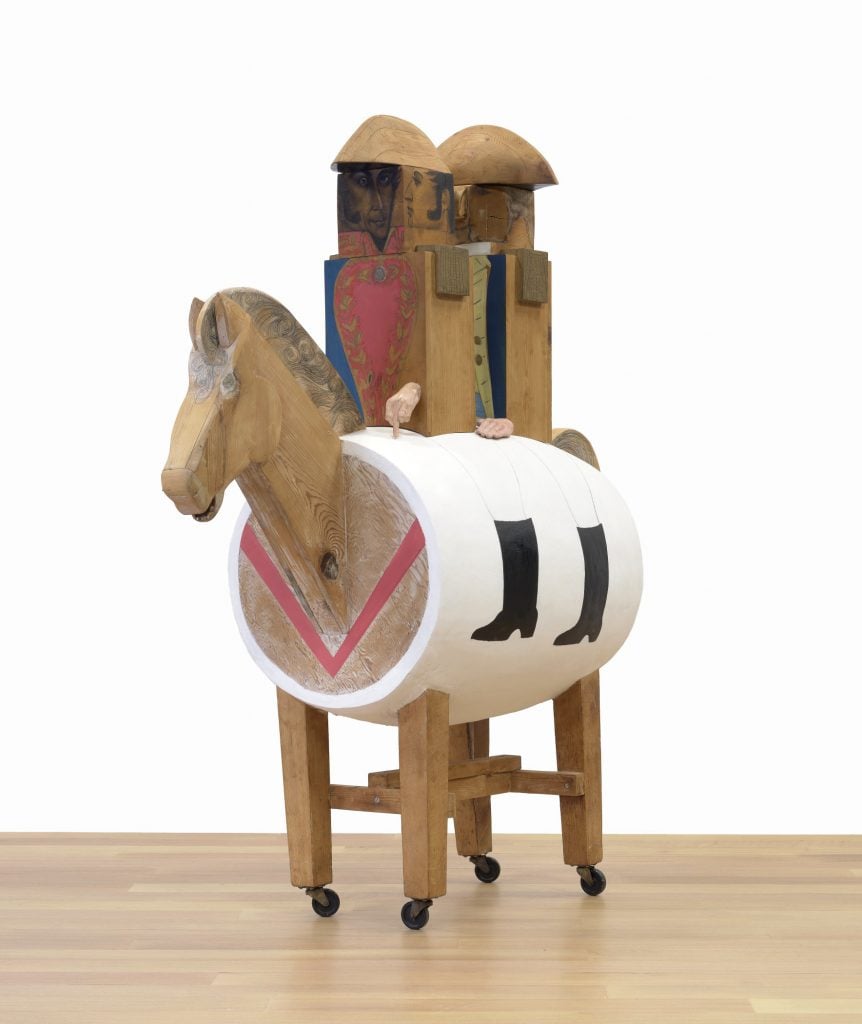
Marisol, The Generals (1961–62). Collection of the Buffalo AKG Art Museum, gift of Seymour H. Knox, Jr. ©Estate of Marisol/Artists Rights Society (ARS), New York.
The AKG acquired the artist’s sculpture The Generals from a 1962 show at New York’s Stable Gallery. The piece is a parody of a traditional equestrian monument, the stylized figures of George Washington and Simon Bolivar, riding together on a toy horse.
“This was the height of the Cold War, and the United States was using friendly Latin America countries as a bulwark against Cuba and the incursion of communism into the United States,” Chaffee said. “One art historian has called it an awkward Inter-American horseback ride.”
Because Marisol’s most commercially and critically successful period came in the 1960s—her breakthrough was a 1957 solo show in New York with famed dealer Leo Castelli—most of those works sold during her lifetime. The AKG had to rely largely on loans to cover the decade in the retrospective.
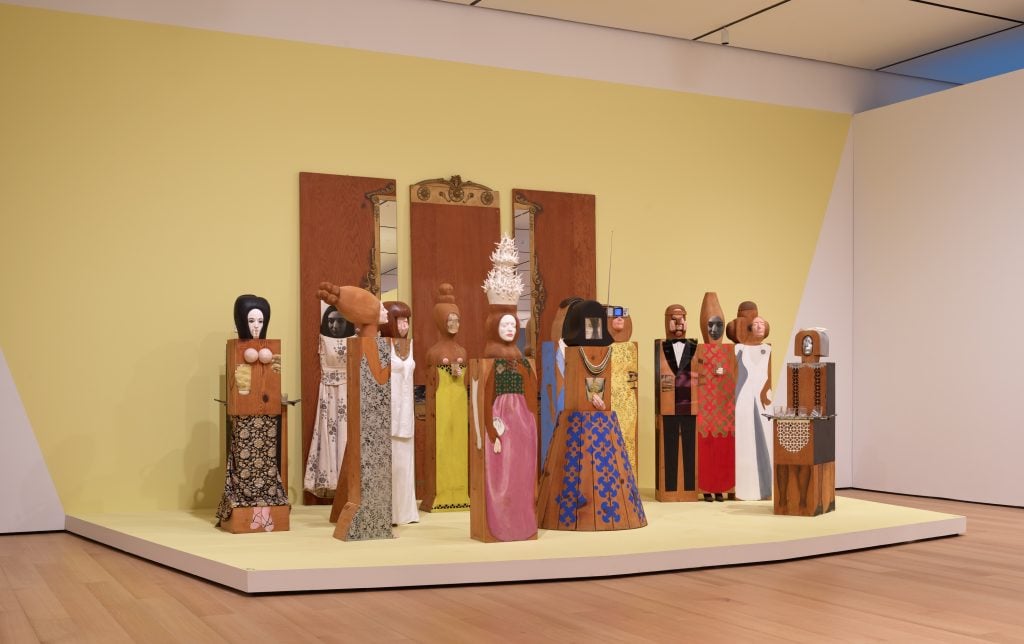
“Marisol: A Retrospective,” installation view at the the Buffalo AKG Art Museum with The Party (1965–66). Photo by Brenda Bieger, courtesy of the Buffalo AKG Art Museum.
One show stopper is The Party (1965–66). On loan from the Toledo Museum, it is made up of 15 life-size, standalone wooden figures each bearing the artist’s visage, representing the discomfort Marisol could feel in social situations. It’s also just generally fabulous, a bevy of fashionable “it girls” in colorful party dresses.
The exhibition opens with early drawings, wooden cat carvings, and a bronze “wedding cake” that Marisol may have made to silence questions about when she planned to marry and have children. (She never did.)
From the the early 1970s, there are wooden fish sculptures and underwater footage Marisol shot while scuba diving for an unrealized documentary about the environmental threat to coral reefs. And from later in the decade, there are more overtly feminist works, with sculptural casts of Marisol’s face and works on paper featuring imprints and tracings of her body.
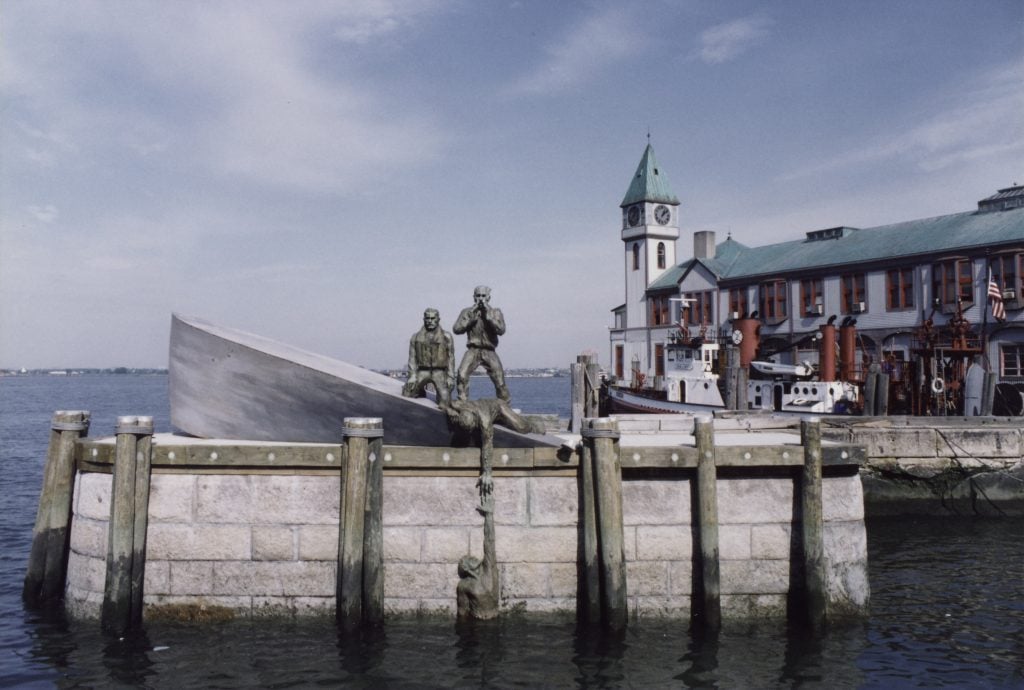
Photograph of Marisol’s American Merchant Mariners’ Memorial (1991). Artwork: The Battery, Manhattan, New York. Photo collection Albright-Knox Art Gallery/Buffalo AKG Art Museum, Marisol Papers, bequest of Marisol, 2016. Marisol Archives, Series 10: Photographs, Subseries 1: Artwork Box Number 3 ©Estate of Marisol/Buffalo AKG Art Museum/Artists Rights Society (ARS), New York.
The show concludes with more large-scale wooden sculptures, from a period where Marisol was largely focused on creating public monuments. (She completed no less than 14 of them, including the poignant American Merchant Mariners’ Memorial on the Battery in New York City.)
The exhibition includes the full-scale wooden model for an unrealized project intended for the Brooklyn Bridge. It memorializes the bridge’s designer, John Augustus Roebling; his son, Washington Roebling, the engineer who supervised its construction; and Washington’s wife, Emily Warren Roebling, who saw the project to completion after John died and Washington became bedridden due to decompression sickness.
It’s a fitting note on which to end. Like Emily, Marisol had very little formal education in her chosen field, yet achieved great things in a male-dominated profession.
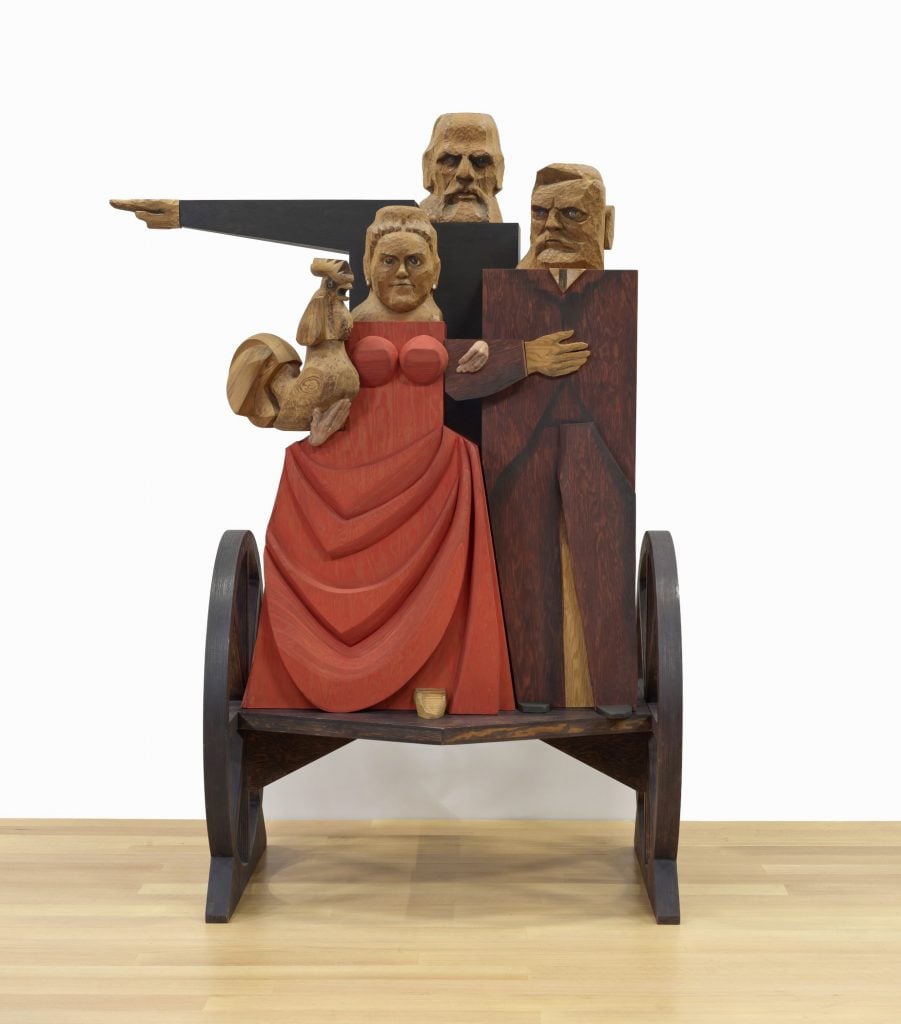
Marisol, John Washington, and Emily Roebling Crossing the Brooklyn Bridge for the First Time (1989). Collection Buffalo AKG Art Museum, Bequest of Marisol, 2016. ©Estate of Marisol/Artists Rights Society (ARS), New York.
The sculpture, John, Washington & Emily Roebling Crossing the Brooklyn Bridge for the First Time, depicts the family in their moment of triumph. Emily—finally recognized after over a decade of overseeing the project from the shadows—holds a rooster as a symbol of victory as the first to cross the new span.
Seeing the work in the final gallery is a hopeful moment. After decades working in obscurity, with the AKG here to safeguard her legacy, Marisol is ready for a long-overdue rediscovery.
“Marisol: A Retrospective” is on view at the Buffalo AKG Art Museum, 1285 Elmwood Avenue, Buffalo, New York, July 12, 2024–January 6, 2025. It will travel to the Dallas Museum of Art, 1717 N Harwood St, Dallas, Texas, February 23–July 6, 2025.





